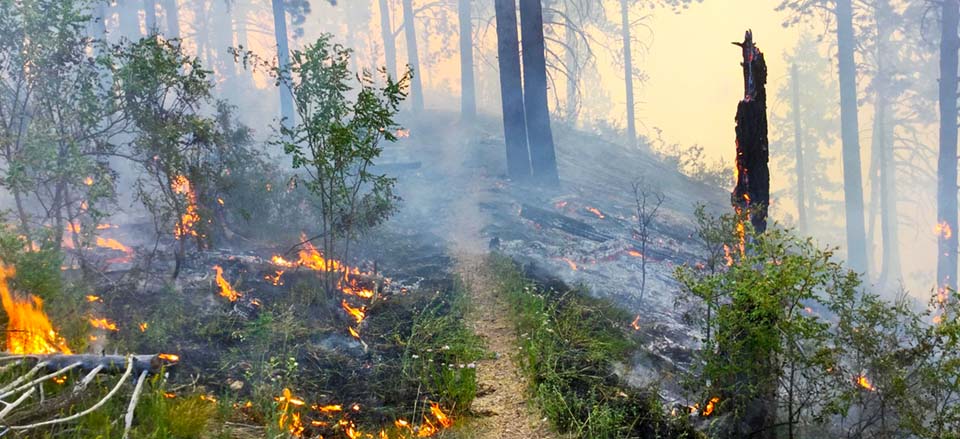
Disaster is too strong a word. Drama and distress, though, are fitting, especially if it’s your only day to tour the Grand Canyon’s North Rim by car. Twenty-five miles of road are closed due to mudslides, the entire east end of the Rim, all the most magnificent accessible views. Visitors, squeezed into the Bright Angel Point area, mill around the Visitor Center with extra cups of coffee.
What happened?
When precipitation follows fire, the results are more complex than you might expect. Let’s start with the Fuller Fire, which burned here this summer for over a month, growing to 14,541 acres.
Lightning-caused fires here are an annual event, have been for ten thousand years. Regular low severity blazes are supposed to happen. There were large fires in 2000 and 2006 as well; it’s easy to pick out the places where young Aspens fight each other for sunlight among the trunks of dead conifers. Regrowth proceeds at a lively pace.
It’s our fear that caused us to essentially do away with fire a century ago. In 1910, the “Great Fire” burned a part of the northwest the size of Connecticut, killing 78 firefighters. Last straw. After that, we began to suppress all fire on public lands. Only recently has that doctrine been questioned and partly overturned.
Charbroiled trees, some standing, some fallen, and scorched earth, empty of underbrush, are what remains of Fuller Canyon now. The fire ran up steep windward hillsides along the road, jumped to the next ridge, blackened parts of the asphalt.
Now we come to this August 18th, the middle of monsoon season. I suspect South Rim folks could see a huge anvil cloud over the North Rim all day. Driving through it myself, I ran into an extended violent hailstorm, probably rain in parts and hail elsewhere, depending on altitude. “Snow’ coated the road three inches deep for quite a while after it finally moved on, at the usual glacial pace of these storms. I’m talking DOWNPOUR.
The millions of dead spruce and fir trees in Fuller Canyon, though, had been shut out of the Earth’s cycle of moisture; they no longer had the ability, the need, to drink. This alpine forest sits on Karst limestone, with a bare minimum of soil. Water seeps through the ground quickly, drops into caves and cracks below. There is little chance for permanent waterways to form. When the region is overloaded by rain, trees are the last defense against flood, and here and now, this badly wounded forest had little chance.
In short, some of the steepest hillsides ended up on the road. Not just here and there, but long stretches had to be plowed off, despite a well-planned and executed road design with the really bad spots already below grade. Those were choked with solidified mud and broken trunks.
Driving through the area in the Government car, we go slowly where there are still twigs and a thin layer of mud. It’s clear that fire and water didn’t mix well in this case. The plow guy says he’s almost done. The burnt smell is strong.
Grass and ferns are bright green against the shiny charcoal ground, already beginning again. Ponderosa pines look terrible, but their thick bark protects them from most fires. It’s the wetter north hillsides of White Fir, Engelmann and Blue Spruce, that had it the worst. Soon, though, the Aspen will colonize the empty ridges.
But it will be a while before the danger of additional landslides is past. This process is part of the recovery, and will happen again and again until roots completely stabilize the slope. Change goes on; in fact, change is permanent. Our efforts at fire suppression, like those of predator suppression, have backfired. The equilibrium of nature was already in place. We don’t see it, because it maintains itself by an occasional alarming ‘disaster’, and because we always see what we want to see.
Standing on Cape Royal by ourselves, we appreciate our luck, the stillness and the view. The road will reopen after lunch. The Painted Desert and the Grand Canyon are sunlit and sublime. From here, there is no sign of trouble anywhere. I wish it wasn’t so, but the evidence is beginning to show that almost everything we’ve ever done to the planet has been dead wrong.
Return to Inspiration Point Blog Index Page.
This blog is meant to encourage awareness and thoughtfulness about the Grand Canyon, one of our most precious resources. It is not merely a story of what happens or has happened here, not a cookbook for what you should make of it yourself, but more an example of the many-faceted inspiration the Canyon nurtures in an artist, perhaps in you. Indeed, inspiration may be the Canyon's greatest resource. These words are sincere, my own take on this world, deliberately non-academic and directed toward users of social media. In no way does it represent the policies or opinions of the National Park Service, although it is done under the auspices of that entity, but is offered in gratitude, with my respect and admiration for these soldiers of conservation. George H. Jacobi 2016
